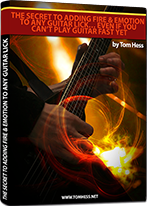How To Use Modulating Pitch Function To Express Emotion In Music
Emotion To Any Guitar Lick

EMAIL TO GET ACCESS
By submitting your info, you agree to send it to Tom Hess Music Corporation who will process and use it according to their privacy policy.
To express emotion in music you need to have advanced musical knowledge and top-level lead guitar technique, right?
Wrong!
Let me show you one of my favorite ways to express emotion in music that you can use to play better lead guitar licks and solos as soon as today.
I call it: Modulating Pitch Function.
What the heck is modulating pitch function?
It’s a musical technique that lets you change how any guitar lick (including all guitar licks for guitar solos you ‘already’ know how to play) feels when you play it.
And believe it or not...
This lead guitar technique has nothing to do with phrasing or vibrato. (Even though phrasing and vibrato also help you express emotion in music.)
Modulating pitch function is about how your guitar lick relates to the chords you are playing the lick over.
Emotion To Any Guitar Lick

EMAIL TO GET ACCESS
By submitting your info, you agree to send it to Tom Hess Music Corporation who will process and use it according to their privacy policy.
To begin...
Watch this lead guitar video that shows you how easy it is to use modulating pitch function to express emotion in music:
Now that you understand the basics of how modulating pitch function works, let’s go deeper.
Here are 5 more lead guitar concepts that make you better at expressing emotion in music and give you more fun ways to apply modulating pitch function in your guitar licks.
Lead Guitar Tip #1 For Expressing Emotion In Music: Vary The Rhythm Of Your Guitar Licks
As you repeat the guitar lick itself over changing chords (to create that cool modulating pitch function effect in your guitar solo) ...
Create some variety by changing the rhythm of notes in the lick.
Here are some ideas for how to do this.
- Make some of the notes of the guitar lick shorter. (e.g. Change from quarter notes to eighth notes or from quarter notes to sixteenth notes).
- Make some of the notes of the guitar lick longer. (e.g. Change from quarter notes to half notes or from sixteenth notes to quarter notes).
- Use syncopation (put accents on the upbeats instead of the downbeats).
- Play the lead guitar lick as triplets instead of 16th notes (or vice versa – as 16th notes instead of triplets).
- Play lead guitar licks over the bar. (This lead guitar video shows you a demonstration of this idea.)
- Write out a list of 10 or more specific rhythms you like (just the rhythms – no notes). And challenge yourself to play your guitar lick (the one you are practicing modulating pitch function with) using those rhythms.
- Use rubato in your lead guitar licks.
What the heck is rubato?
It’s a little-known (and simple) rhythm lead guitar technique that makes your lead guitar solos almost as unique to you as your fingerprints.
It’s a way to stretch time in your guitar licks (and solos) & “milk” emotional drama from the rhythm of your notes.
Yngwie, Jason Becker, Eddie Van Halen, Paul Gilbert, Steve Vai and others all use it in their solos.
Here is how it works and how to do it.
Use any of these rhythm ideas when practicing applying modulating pitch function into your guitar solos.
Question: “But Tom Hess, how do I make time for practicing all of the lead guitar rhythm variations you just listed when I only have about an hour to practice per day and I have a ton of other things to practice?”
Answer: Practice rotating your focus between these lead guitar rhythm variations each time you practice.
For example:
On day 1, you can do rubato practice (in combination with modulating pitch function).
On day 2, you can practice playing over the bar (while also using modulating pitch function).
On day 3, use syncopation, etc.
Lead Guitar Tip #2 For Expressing Emotion In Music: Vary The Phrasing Of Your Guitar Licks
Similar to how you would practice varying the rhythm of the notes in your guitar lick (as you are applying modulating pitch function)...
You can (and should) vary the phrasing of the notes to help you express emotion in music on a deeper level... all without changing the lick.
 How To Compose Great Guitar Solos
How To Compose Great Guitar SolosDiscover the process for composing great guitar solos.
 Make Your Guitar Solos More Unique
Make Your Guitar Solos More UniqueLearn how to make your lead guitar solos sound unique.
 How To Create Kick Ass Guitar Solos
How To Create Kick Ass Guitar SolosLearn how to play guitar solos much
more creatively.
How do you vary the phrasing of a lead guitar lick?
Here are a few very simple ideas to try during your next lead guitar solo:
- Vary how and when vibrato is applied in your guitar lick. For example: you can add vibrato instantly to a note in a guitar lick... or you can delay it.
This guitar vibrato video shows you how.
- Vary how you bend strings. Everyone knows about the ‘regular’ bends (half step and whole step) and pre-bends... but that’s where it stops for most lead guitar players.
Few guitarists know advanced lead guitar string bending variations, like:
- Half-ghosted guitar string bends
- Over the bar line string bending guitar licks
- Double stop guitar string bends (but not the “bluesy” kind)
- Guitar string bend chains
Here is how to do these lead guitar string bend variations:
You can mix these string bending ideas into your lead guitar licks while you are practicing applying the idea of modulating pitch function.
Bonus lead guitar playing tip: when you do lead guitar string bends, make sure to wrap your fretting hand’s thumb over the bar to give yourself more control, like this:

- Vary how you apply slides in your guitar licks. Almost everyone knows how to do ascending and descending slides. But few guitarists know (or use) backslides, re-articulation slides or super slides to express emotion in music.
Question: “Tom Hess, what are backslides, re-articulation slides and super slides?”
Answer: A backslide consists of first playing the note you want to hear, then sliding up (or down) from it and returning back to the original note.
Here is a demonstration of backslides in action:
A super slide is simply a slide of more than 12 frets (one octave).
And a re-articulation slide happens when you play the note you want to hear and immediately play it again (re-articulate it) by sliding into it.
You can apply these lead guitar phrasing variations the same exact way you’d apply the rhythm variations discussed earlier.
Simply alternate your focus from one to the next during your lead guitar practice sessions and soon you’ll become fluent in all of them.
You can also try this technique that will help you express emotion in music:
Play your guitar lick once and ask yourself: “how expressive did this lead guitar lick sound on a scale of 1-10?”
Then, if the sound of your guitar lick wasn’t a ‘10’, ask: “how might I make it better?”
Next, refine the guitar lick you played using one of the lead guitar lick phrasing variations I showed you.
Here is how this process might look:
This ‘grading’ technique is a fantastic way to level-up the sound of your lead guitar solos and improve your ability to express emotion in music.
Lead Guitar Tip #3 For Expressing Emotion In Music: Use Lick Sequencing In Your Lead Guitar Licks.
As the name implies, this way of expressing emotion in music is about taking your original lead guitar lick and sequencing it through a scale as you practice applying modulating pitch function in your guitar solos.
Like this:
Question: “But Tom Hess, won’t lick sequencing change the original lick?”
Answer: No, because you’re still dealing with the same notes in the scale (5 or 7, depending on what scale you are using) no matter how you sequence it.
So, even though the notes of your guitar lick move higher or lower (in pitch), the idea of modulating pitch function works the same way.
Sequencing simply adds a bit of variety to simply playing the same guitar lick over and over again.
Lead Guitar Tip #4 For Expressing Emotion In Music: Vary The Articulation Of The Notes In Your Guitar Licks
Here are some of the ways to vary the articulation of notes in your lead guitar licks and guitar solos as you practice applying modulating pitch function and learning to express emotion in music:
- Alternate between picking and legato. Change some of the picked notes to hammer ons and pull offs (and change some of the hammer ons and pull offs to picked notes).
- Vary the dynamics of the notes. Instead of picking everything as aggressively as possible (or as softly as possible)...
... treat your picking hand as a volume knob that makes the pick attack softer or louder as you play the notes of your lead guitar licks in your guitar solos.
- Add picking hand rakes to the notes you play on the highest (thinnest) guitar strings. (Especially the ‘long’ notes that ring out for several seconds at a time.)
Simply brush the pick across the lower strings as it reaches strings B and high E to create the rake effect.
This makes your highest pitches sound thicker and more expressive.
- Add pinch harmonics to some of the notes in your lead guitar lick as you repeat it over and over. This adds more variety to the lick and – together with the idea of modulating pitch function – helps you express emotion in music at a higher level.
Watch this video to see how to do pinch harmonics the right way in your guitar licks and guitar solos:
Lead Guitar Tip #5 For Expressing Emotion In Music: Get Feedback On Your Lead Guitar Playing From An Expert Guitar Teacher
How is this helpful for your ability to express emotion in music and play better guitar licks and guitar solos?
Simple:
Even if you know ‘what to do’ to develop your lead guitar playing...
There is only so much you can analyze about your guitar playing (i.e. your ability to express emotion in music and play cool guitar solos) on your own.
As a result: it’s very easy to develop bad habits that you’ll either spend a lot of time undoing... or pay a lot of money to some guitar teacher to help you fix later.
Meanwhile: feedback on your lead guitar playing from a great guitar teacher helps you spot flaws in your lead guitar playing ‘before’ they turn into bad habits.
From this, you not only spend less time being frustrated...
You also get to reach your guitar playing goals a lot faster and have way more fun playing guitar.
And speaking of getting feedback on your lead guitar playing...
Now that you know the basics of expressing emotion in music, I’d like to help you develop the rest of your guitar playing and musical skills and truly reach your goals.
I can show you how in my Breakthrough Guitar Lessons.
Here is how it works:
You tell me everything about your guitar playing strengths, weaknesses, musical background, and musical goals. I then create your personalized guitar lesson strategy. As you practice your lessons, I give you a ton of feedback to help you master your guitar lessons and reach your musical goals.
I’ve helped thousands of guitar players play the way they never thought they could. And you can be next.
To begin, click the green “Start Now” button below.

Learn guitar from the best rock guitar tutor online.

